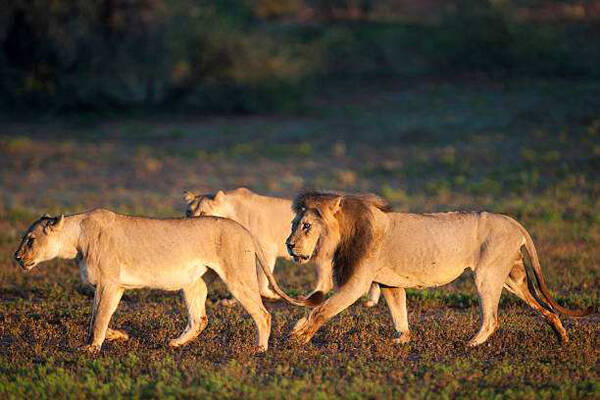Panthera leo vernayi
IUCN
LCBasic Information
Scientific classification
- name:Panthera leo vernayi
- Scientific Name:Panthera leo vernayi,Katanga Lion
- Outline:Carnivora
- Family:Schizopoda Felidae Panthera
Vital signs
- length:About 2 meters
- Weight:110-250kg
- lifetime:20-25 years
Feature
Its ability to withstand thirst and heat is better than other subspecies of lions.
Distribution and Habitat
Distributed in Zimbabwe, South Africa, Botswana, Etosha Park, Namibia and the Kalahari Desert
Appearance
Compared with lions in other regions, the Kalahari lion has a lighter and more agile body frame, and its limbs are slender and strong. The body hair is light brown to gray-brown, which varies according to gender, age and individual. The male lion has thick dark black mane on the top of the head, neck and shoulders, which hangs down to the throat, chest and base of the front legs. The mane around the cheeks is generally lighter than the hair on the body. It varies according to individuals and ages, and can be light yellow, golden and light brown. Female lions have no mane. Both male and female lions have black spherical tufts of hair at the end of their tails. The canines and carnassial teeth are very developed, the molars are relatively degenerate, and the claws are very sharp and retractable. As the second largest cat in the world, the African lion has a light yellow-brown fur color. When standing, the male lion is up to 110cm tall at the shoulder, and the total length can reach 3 met
Details
The scientific name of the Kalahari lion is Panthera leo vernayi, which is one of the largest lion subspecies in existence.

Kalahari lions usually live in groups, with a lion group of about 8 to 30 members, usually 15 members. It often contains two to four adult female lions, at least one adult male lion and some growing lion cubs. Lions mainly hunt at night. The cover of night brings a higher success rate. At the same time, it can also avoid the scorching sun during the day. The prey of Kalahari lions includes impala warthogs, Kobus kob, hartebeest, oryx plains zebras, eland, African buffalo and even giraffes and African Elephants-Are-Endangered.html">elephants. For lions living in the Kalahari, warthogs and oryx are their main food sources. Scientific research on lion prey records in the Kalahari National Park from July 1970 to January 1983 showed that these two items accounted for 57.3% of the prey.
A characteristic of Kalahari lions is that in addition to preying on medium and large ungulates in teams like other lion groups, they also frequently prey on small animals such as hares and porcupines alone. In terms of numbers, Kalahari lions kill more animals than lions in other parts of Africa. This is because their prey is small. An African lion kills 12 to 36 prey a year. In Kruger, the number is 15, and in the Kalahari it is 50.
A lion group's territory can be as small as 20 square kilometers in places where prey is abundant; in areas where prey is sparse, they have to establish a territory as large as 400 square kilometers. According to a survey, Katanga lions living in the Kalahari migrate more frequently in their territory, usually at night, and Kalahari lions move an average of 11.8 kilometers per night. Female lions move longer distances than male lions. There was once a female lion who walked 41.2 kilometers in one night (the female lion moved an average of 16.2 kilometers per night in 10 nights). There is also a record of six females and a young male lion (2-3 years old) walking 33.6 kilometers in one night. The record of male lions is: two male lions traveled an average of 15.1 kilometers per night in six nights.
During the estrus period, females chased males and rolled around. The gestation period of females is 105-116 days, and each litter has 2-3 cubs, and there are also up to 5 cubs, mostly born in grass or caves. Newborn cubs weigh about 0.5 kg, are blind, grow teeth after 15 days, and have dark brown spots or stripes on their bodies, which gradually disappear after about half a year.
Listed in the 2008 Red List of Endangered Species of the World Conservation Union (IUCN) ver 3.1 - Vulnerable (VU).
Protect wild animals and stop eating game.
Maintaining ecological balance is everyone's responsibility!








